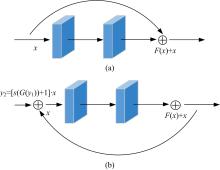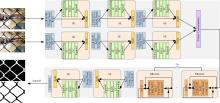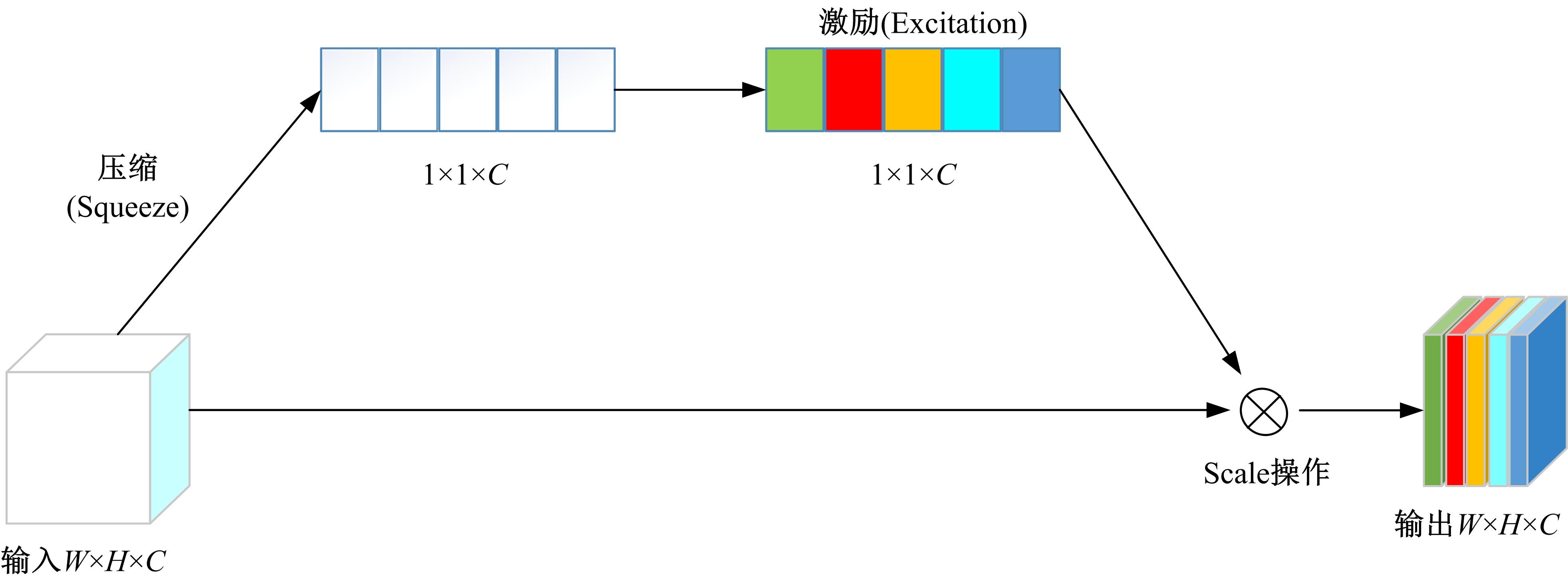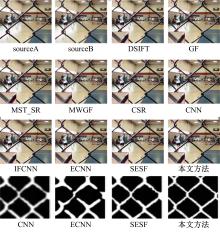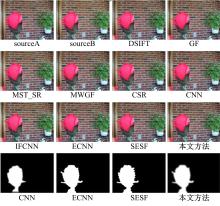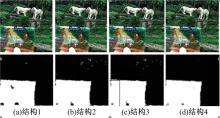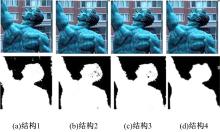Journal of Jilin University(Engineering and Technology Edition) ›› 2022, Vol. 52 ›› Issue (8): 1857-1864.doi: 10.13229/j.cnki.jdxbgxb20211096
Multi⁃focus image fusion algorithm based on pixel⁃level convolutional neural network
Xuan-jing SHEN1,2( ),Xue-feng ZHANG1,2,Yu WANG1,2,Yu-bo JIN3(
),Xue-feng ZHANG1,2,Yu WANG1,2,Yu-bo JIN3( )
)
- 1.College of Computer Science and Technology,Jilin University,Changchun 130012,China
2.Key Laboratory of Symbolic Computation and Knowledge Engineering of Ministry of Education,Jilin University,Changchun 130012,China
3.Changchun Expert Information Technology Co. ,Ltd. ,Changchun 130012,China
CLC Number:
- TP391
| 1 | Li S, Kang X, Fang L, et al. Pixel-level image fusion: a survey of the state of the art[J]. Information Fusion, 2017, 33: 100-112. |
| 2 | Huang W, Jing Z. Evaluation of focus measures in multi-focus image fusion[J]. Pattern Recognition Letters, 2007, 28(4): 493-500. |
| 3 | Aslantas V, Kurban R. Fusion of multi-focus images using differential evolution algorithm[J]. Expert Systems with Applications, 2010, 37(12): 8861-8870. |
| 4 | Liu Y, Liu S, Wang Z. Multi-focus image fusion with dense SIFT[J]. Information Fusion, 2015, 23: 139-155. |
| 5 | Hill P, Al-Mualla M E, Bull D. Perceptual image fusion using wavelets[J]. IEEE Transactions on Image Processing, 2016, 26(3): 1076-1088. |
| 6 | Yu B, Jia B, Ding L, et al. Hybrid dual-tree complex wavelet transform and support vector machine for digital multi-focus image fusion[J]. Neurocomputing, 2016, 182: 1-9. |
| 7 | 张强,郭宝龙.基于Curvelet变换的图像融合算法[J]. 吉林大学学报: 工学版, 2007, 37(2): 458-463. |
| Zhang Qiang, Guo Bao-long. Image fusion algorithm based on Curvelet transform[J]. Journal of Jilin University(Engineering and Technology Edition), 2007, 37(2): 458-463. | |
| 8 | 孙伟, 郭宝龙, 陈龙. 非降采样Contourlet域方向区域多聚焦图像融合算法[J]. 吉林大学学报: 工学版, 2009, 39(5): 1384-1389. |
| Sun Wei, Guo Bao-long, Chen Long. Multi-focus image fusion algorithm for non-down-sampling Contourlet domain direction region[J]. Journal of Jilin University(Engineering and Technology Edition), 2009, 39(5): 1384-1389. | |
| 9 | Bhatnagar G, Wu Q M J, Liu Z. Directive contrast based multimodal medical image fusion in NSCT domain[J]. IEEE Transactions on Multimedia, 2013, 15(5): 1014-1024. |
| 10 | Liu X, Mei W, Du H. Multi-modality medical image fusion based on image decomposition framework and nonsubsampled shearlet transform[J]. Biomedical Signal Processing and Control, 2018, 40: 343-350. |
| 11 | Liu Y, Chen X, Peng H, et al. Multi-focus image fusion with a deep convolutional neural network[J]. Information Fusion, 2017, 36: 191-207. |
| 12 | Zhang Y, Liu Y, Sun P, et al. IFCNN: a general image fusion framework based on convolutional neural network[J]. Information Fusion, 2020, 54: 99-118. |
| 13 | Amin-Naji M, Aghagolzadeh A, Ezoji M. Ensemble of CNN for multi-focus image fusion[J]. Information fusion, 2019, 51: 201-214. |
| 14 | Gai D, Shen X, Chen H, et al. Multi-focus image fusion method based on two stage of convolutional neural network[J]. Signal Processing, 2020, 176: 107681. |
| 15 | Ma B, Zhu Y, Yin X, et al. Sesf-fuse: an unsupervised deep model for multi-focus image fusion[J]. Neural Computing and Applications, 2021, 33(11): 5793-5804. |
| 16 | Zhang H, Le Z, Shao Z, et al. MFF-GAN: an unsupervised generative adversarial network with adaptive and gradient joint constraints for multi-focus image fusion[J]. Information Fusion, 2021, 66: 40-53. |
| 17 | Li S, Kang X, Hu J. Image fusion with guided filtering[J]. IEEE Transactions on Image Processing, 2013, 22(7): 2864-2875. |
| 18 | Fakhari F, Mosavi M R, Lajvardi M M. Image fusion based on multi-scale transform and sparse representation: an image energy approach[J]. Iet Image Processing, 2017, 11(11): 1041-1049. |
| 19 | Zhou Z, Li S, Wang B. Multi-scale weighted gradient-based fusion for multi-focus images[J]. Information Fusion, 2014, 20: 60-72. |
| 20 | Liu Y, Chen X, Ward R K, et al. Image fusion with convolutional sparse representation[J]. IEEE Signal Processing Letters, 2016, 23(12): 1882-1886. |
| 21 | Liu Y, Chen X, Peng H, et al. Multi-focus image fusion with a deep convolutional neural network[J]. Information Fusion, 2017, 36: 191-207. |
| [1] | Ming-hua GAO,Can YANG. Traffic target detection method based on improved convolution neural network [J]. Journal of Jilin University(Engineering and Technology Edition), 2022, 52(6): 1353-1361. |
| [2] | Huai-jiang YANG,Er-shuai WANG,Yong-xin SUI,Feng YAN,Yue ZHOU. Simplified residual structure and fast deep residual networks [J]. Journal of Jilin University(Engineering and Technology Edition), 2022, 52(6): 1413-1421. |
| [3] | Xue-zhi WANG,Qing-liang LI,Wen-hui LI. Spatio⁃temporal model of soil moisture prediction integrated with transfer learning [J]. Journal of Jilin University(Engineering and Technology Edition), 2022, 52(3): 675-683. |
| [4] | Xiang-jun LI,Jie-ying TU,Zhi-bin ZHAO. Validity classification of melting curve based on multi⁃scale fusion convolutional neural network [J]. Journal of Jilin University(Engineering and Technology Edition), 2022, 52(3): 633-639. |
| [5] | Ji-hong OUYANG,Ze-qi GUO,Si-guang LIU. Dual⁃branch hybrid attention decision net for diabetic retinopathy classification [J]. Journal of Jilin University(Engineering and Technology Edition), 2022, 52(3): 648-656. |
| [6] | Xian-tong LI,Wei QUAN,Hua WANG,Peng-cheng SUN,Peng-jin AN,Yong-xing MAN. Route travel time prediction on deep learning model through spatiotemporal features [J]. Journal of Jilin University(Engineering and Technology Edition), 2022, 52(3): 557-563. |
| [7] | Lin SONG,Li-ping WANG,Jun WU,Li-wen GUAN,Zhi-gui LIU. Reliability analysis based on cyber⁃physical system and digital twin [J]. Journal of Jilin University(Engineering and Technology Edition), 2022, 52(2): 439-449. |
| [8] | Jie CAO,Jia-lin MA,Dai-lin HUANG,Ping YU. A fault diagnosis method based on multi Markov transition field [J]. Journal of Jilin University(Engineering and Technology Edition), 2022, 52(2): 491-496. |
| [9] | Wen-zhi GAO,Yan-jun WANG,Xin-wei WANG,Pan ZHANG,Yong LI,Yang DONG. Real⁃time diagnosis for misfire fault of diesel engine based on convolutional neural network [J]. Journal of Jilin University(Engineering and Technology Edition), 2022, 52(2): 417-424. |
| [10] | Long ZHANG,Tian-peng XU,Chao-bing WANG,Jian-yu YI,Can-zhuang ZHEN. Gearbox fault diagnosis baed on convolutional gated recurrent network [J]. Journal of Jilin University(Engineering and Technology Edition), 2022, 52(2): 368-376. |
| [11] | Liang DUAN,Chun-yuan SONG,Chao LIU,Wei WEI,Cheng-ji LYU. State recognition in bearing temperature of high-speed train based on machine learning algorithms [J]. Journal of Jilin University(Engineering and Technology Edition), 2022, 52(1): 53-62. |
| [12] | You QU,Wen-hui LI. Single-stage rotated object detection network based on anchor transformation [J]. Journal of Jilin University(Engineering and Technology Edition), 2022, 52(1): 162-173. |
| [13] | Gui-xia LIU,Zhi-yao PEI,Jia-zhi SONG. Prediction of protein-ATP binding site based on deep learning [J]. Journal of Jilin University(Engineering and Technology Edition), 2022, 52(1): 187-194. |
| [14] | Jie ZHANG,Wen JING,Fu CHEN. Vulnerability detection of instant messaging network protocol based on passive clustering algorithm [J]. Journal of Jilin University(Engineering and Technology Edition), 2021, 51(6): 2253-2258. |
| [15] | Hui ZHONG,Heng KANG,Ying-da LYU,Zhen-jian LI,Hong LI,Ruo-chuan OUYANG. Image manipulation localization algorithm based on channel attention convolutional neural networks [J]. Journal of Jilin University(Engineering and Technology Edition), 2021, 51(5): 1838-1844. |
|
||
